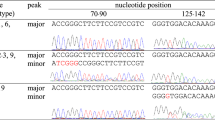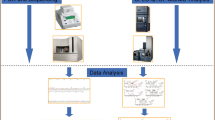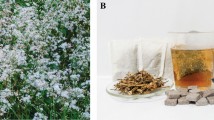Abstract
During recent years, ayurvedic plants have entered the European market as a novel food trend. This confronts food analytics with the task to assess the composition of exotic and often unknown herbal preparations in teas or spices. Using the trend plant ‘Tulsi’ (Holy Basil, Ocimum tenuiflorum L.) as model, we developed microscopical diagnostics on markers that can be reliably assessed in dried or even fragmented specimens as typically occurring in commercial ayurvedic preparations, where DNA extraction is difficult. First, a reference for ‘Tulsi’ was defined based on the plastidic internal transcribed spacer (ITS) as marker. Second, this reference was morphologically delineated from other Ocimum accessions potentially used as surrogates for ‘Tulsi’ (such as O. basilicum L.) leading to a microscopical assay based on the density of glandular scales and glandular hairs, the epidermis with trichomes and the cells of the palisade parenchyma. Third, this assay was statistically validated for its ability to discriminate surrogate species from true O. tenuiflorum. First applications of this assay on commercial ‘Tulsi’ products demonstrated a high frequency of surrogate additions.



Similar content being viewed by others
References
Singh N, Hoette Y, Miller R (2002) Tulsi, the mother medicine of nature. International Institute of Herbal Medicine, Lucknow
Zoller A, Nordwig H (1997) Heilpflanzen der ayurvedischen Medizin, Karl F. Haug Verlag, Heidelberg, p 393
Bhargava KP, Sing N (1981) Anti-stress activity of Ocimum sanctum. Ind J Med Res 73:443–451
Mediratta PK, Sharma KK (2000) Effect of essential oil of the leaves and fixed oil of the seed of Ocimum sanctum on immune response. J Med Aromat Plant Sci 22:694–700
Agarwal P, Rai V, Singh RB (1996) Randomized placebo-controlled, single blind trail of holy basil leaves in patients with noninsulin-dependent mellitus. Int J Clin Pharmacol Ther 34:406–409
Klein G, Raabe H-J, Weiss H (2007) Textsammlung Lebensmittelrecht. Behrs Verlag, Hamburg
Eschrich W (2000) Pulveratlas der Drogen. Deutscher Apothekerverlag, Stuttgart
Eckelmann S (2003) Biodiversität der Gattung Ocimum (L.), insbesondere der Kultursippen. PhD dissertation, University of Kassel
Paton A, Harley MR, Harley MM (1999) Ocimum—an overview of classification and relationships. In: Hiltunen R, Basil H (eds) The genus Ocimum. Harwood Academic Press, Amsterdam, pp 1–38
Zhang XY, Ehrlich M (1994) Detection and quantitation of low numbers of chromosomes containing rbcL-2 oncogene translocations using semi-nested PCR. Biotechniques 16:502–507
Acknowledgments
We acknowledge Angelika Piernitzki and Joachim Daumann, Botanical Garden of the University, for excellent horticultural support during the project, Sabine Eckelmann of the University Kassel for providing DNA sequences of O. basilicum and O. tenuiflorum, and the Botanical Gardens of the Universities of Bayreuth and Göttingen, as well as the GBIS Gatersleben for sending seeds of Ocimum spp.
Author information
Authors and Affiliations
Corresponding author
Rights and permissions
About this article
Cite this article
Jürges, G., Beyerle, K., Tossenberger, M. et al. Development and validation of microscopical diagnostics for ‘Tulsi’ (Ocimum tenuiflorum L.) in ayurvedic preparations. Eur Food Res Technol 229, 99–106 (2009). https://doi.org/10.1007/s00217-009-1030-3
Received:
Revised:
Accepted:
Published:
Issue Date:
DOI: https://doi.org/10.1007/s00217-009-1030-3




